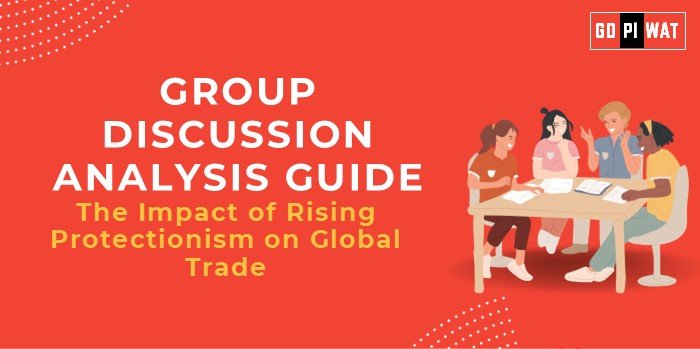📋 Group Discussion (GD) Analysis Guide
🌟 The Impact of Rising Protectionism on Global Trade
🌐 Introduction to the Topic
Opening Context: Global trade has driven economic growth, innovation, and poverty reduction. However, the resurgence of protectionism threatens these gains by disrupting supply chains, inflating costs, and exacerbating geopolitical tensions.
Topic Background: Protectionism, marked by increased tariffs, subsidies, and non-tariff barriers, has been intensifying in recent years. The U.S.–China trade war and Brexit are prominent examples, underlining a shift from globalization to economic nationalism.
📊 Quick Facts and Key Statistics
- 📈 Global Tariff Increases: The global average tariff rate increased from 6.5% (2017) to 8.7% (2023), highlighting the reversal of trade liberalization.
- 📉 Trade Volume Decline: WTO estimates global trade volume growth slowed to 1.7% in 2023, down from 4.5% in 2018.
- 💸 Subsidies Surge: Government subsidies to domestic industries rose by 30% globally between 2020 and 2023, complicating fair competition.
- 🌍 Impact on Emerging Economies: Developing countries face a $300 billion shortfall in export revenues annually due to rising tariffs and protectionist policies.
🤝 Stakeholders and Their Roles
- 🏛️ Governments: Implementing tariffs, subsidies, and regulations, they play a direct role in shaping trade policies.
- 🏢 Businesses: Both multinational and local firms must adapt to supply chain disruptions and increased costs.
- 🌐 International Organizations: WTO and IMF advocate for free trade and mediate disputes.
- 👥 Consumers: Bear the brunt of increased prices and reduced product variety due to protectionism.
📋 Achievements and Challenges
- 🏆 Achievements:
- Protects critical industries, preserving jobs and economic stability (e.g., U.S. steel tariffs saving 16,000 jobs in 2019).
- Benefits local businesses by reducing foreign competition.
- ⚠️ Challenges:
- Supply chain disruptions lead to higher prices (e.g., semiconductor shortages due to U.S.–China trade tensions).
- Retaliatory tariffs exacerbate economic instability.
- Reduced global cooperation undermines climate and health initiatives dependent on cross-border trade.
- 🌍 Global Comparisons:
- ✅ Success: China’s focus on self-reliance has spurred domestic innovation.
- ❌ Failure: Argentina’s import restrictions led to inflation and economic stagnation.
📚 Structured Arguments for Discussion
- 👍 Supporting Stance: “Protectionism safeguards national interests, preserves local jobs, and ensures strategic industries remain robust.”
- 👎 Opposing Stance: “Protectionism stifles innovation, inflates consumer costs, and hinders global economic recovery.”
- ⚖️ Balanced Perspective: “While protectionism may address short-term goals, its long-term impact on global growth and cooperation requires scrutiny.”
✅ Effective Discussion Approaches
- Opening Approaches:
- Begin with impactful statistics like the WTO’s trade volume slowdown.
- Use a real-world example like the U.S.–China trade conflict to anchor the discussion.
- Counter-Argument Handling:
- Highlight the temporary benefits of protectionism while presenting the broader drawbacks.
- Cite evidence, such as trade agreement collapses, to counter over-optimistic views.
📊 Strategic Analysis of Strengths and Weaknesses
- 💪 Strengths: Protects critical industries, creates local jobs, ensures economic stability in volatile sectors.
- ⚡ Weaknesses: Discourages competition, increases consumer prices, strains international relations.
- 🚀 Opportunities: Encourages domestic innovation, allows for self-reliance in strategic areas.
- 🌐 Threats: Global retaliation, trade wars, and a fractured global economy.
🌍 Connecting with B-School Applications
- 📈 Real-World Applications: Analyze trade policies’ impact on global supply chains or how companies adapt to tariff changes.
- 💬 Sample Interview Questions:
- “How does rising protectionism impact global economic recovery?”
- “Discuss a sector that benefits from protectionist policies.”
- 💡 Insights for B-School Students:
- Develop frameworks for analyzing trade disruptions.
- Explore trade’s role in corporate strategy.


